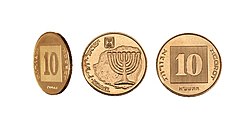10 agorot controversy

The 10 agorot controversy refers to a


Arafat's claims
In support of his claim that the 10 agorot coins displayed a Greater Israel, Arafat also quoted a 1989 paper by Gwyn Rowley of the
Whereas Israel has never formally defined its borders one possible indication of Israel's broader territorial ambitions might be seen in the Israeli ten agorot coin which carries a map, seemingly depicting an area that would extend over to encompass present-day Amman, Beirut, Baghdad, Damascus and the N parts of Saudi Arabia. This same territorial depiction was carried on the earlier one sheqal coin.[5]
S. M. Berkowicz, of the Department of Physical Geography, at the Hebrew University of Jerusalem criticized Rowley's article in a subsequent paper also published by GeoJournal. Berkowicz concluded that the shape was based on an ancient coin and "There is of course no foundation to Rowley's undocumented claim."[6] Rowley then responded that the coin might have been chosen because of its map-like shape.[3]
Arafat's meeting in Geneva generated widespread global media coverage.[3]
Details of design
The Bank of Israel maintains that the 10 agorot design was selected for its historical value, and is a "replica of a coin issued by Mattathias Antigonus (40–37 B.C.E.) with the seven-branched candelabrum".[7]
The design, by Nathan Karp, first appeared on the 100 shekel coin issued by the Bank of Israel on 2 May 1984.[8] When the old shekel currency was replaced by the new shekel in September 1985, the design was copied to the new 10 agorot coin, which was equal in value to the old 100 shekel. This design was also adopted as the symbol of the Bank of Israel.
References
- ^ ISBN 0312176880.
- ^ Yasir Arafat: A Political Biography: A Political Biography, Barry Rubin. Page 241
- ^ S2CID 189889311.
- ISBN 978-0-312-17688-4.
- S2CID 189891013.
- ^ GeoJournal, March 1991, Volume 23, Issue 3, pp. 187–196, "Developing perspectives upon the areal extent of Israel: A reply", S. M. Berkowicz
- ^ "10 Agora (need to click "Coins", then "10 Agora")". Archived from the original on 25 September 2016. Retrieved 16 February 2016. A picture of the coin is available on the Bank of Israel Currency exhibition [1]
- ^ "Past Notes & Coins Series". Archived from the original on 29 November 2012. Retrieved 10 January 2013.
External links
- "10 agorot". Bank of Israel (BOI). Archived from the original on 29 September 2007.
Replica of a coin issued by Mattathias Antigonus (37 - 40 B.C.E.) with the seven-branched candelabrum; the emblem of the State of Israel; "Israel" in Hebrew, Arabic and English
- "10 agorot". Current currency series. BOI. Archived from the original on 31 October 2019.
See tab Coins, select: Agora and New Sheqel Series, select 10 agorot
- "100". Past Notes & Coins Series. BOI. Archived from the original on 27 October 2012. Retrieved 27 March 2017.
See tab Coins, select: New Agora and Sheqel Series, select 100 Sheqalim
